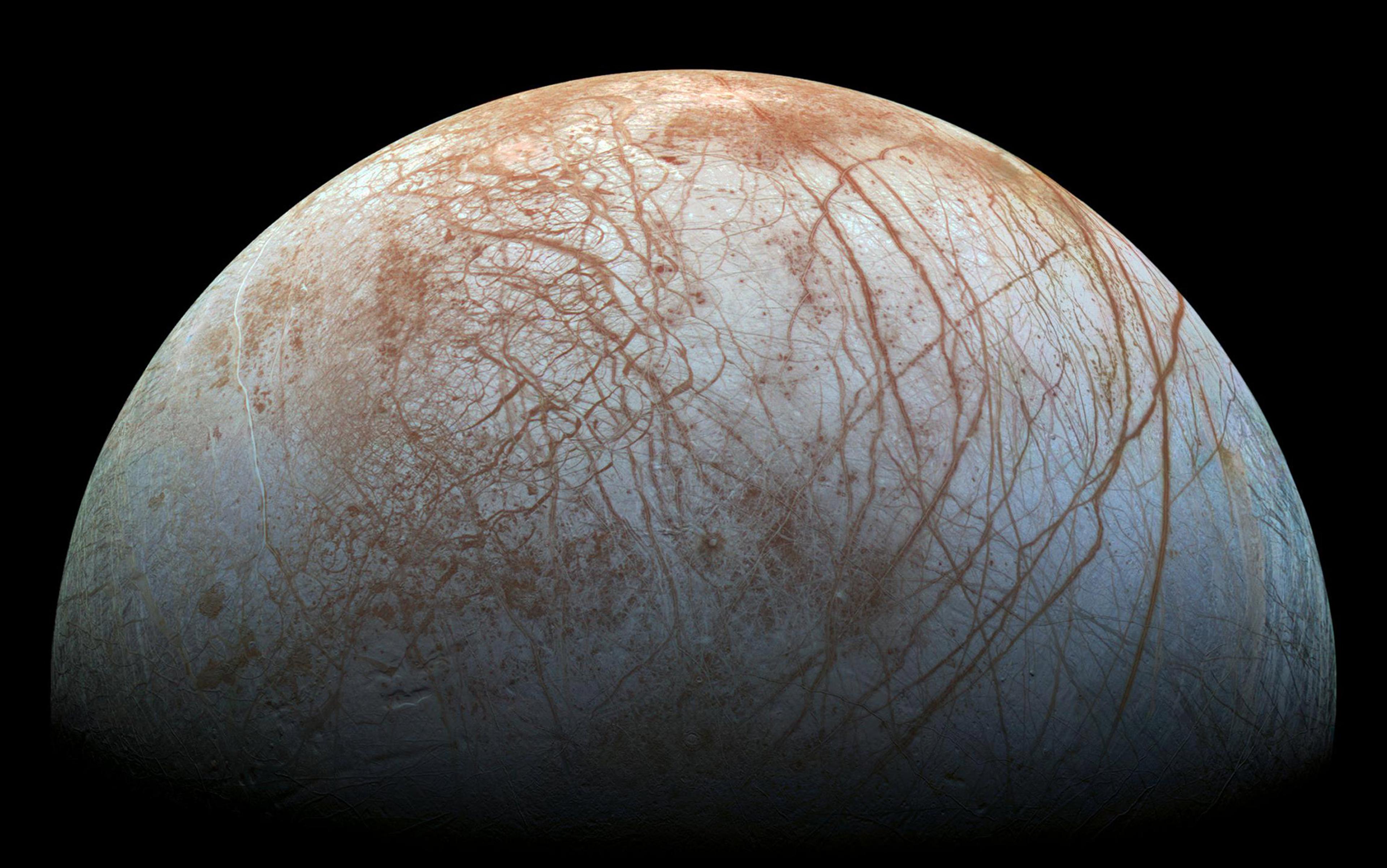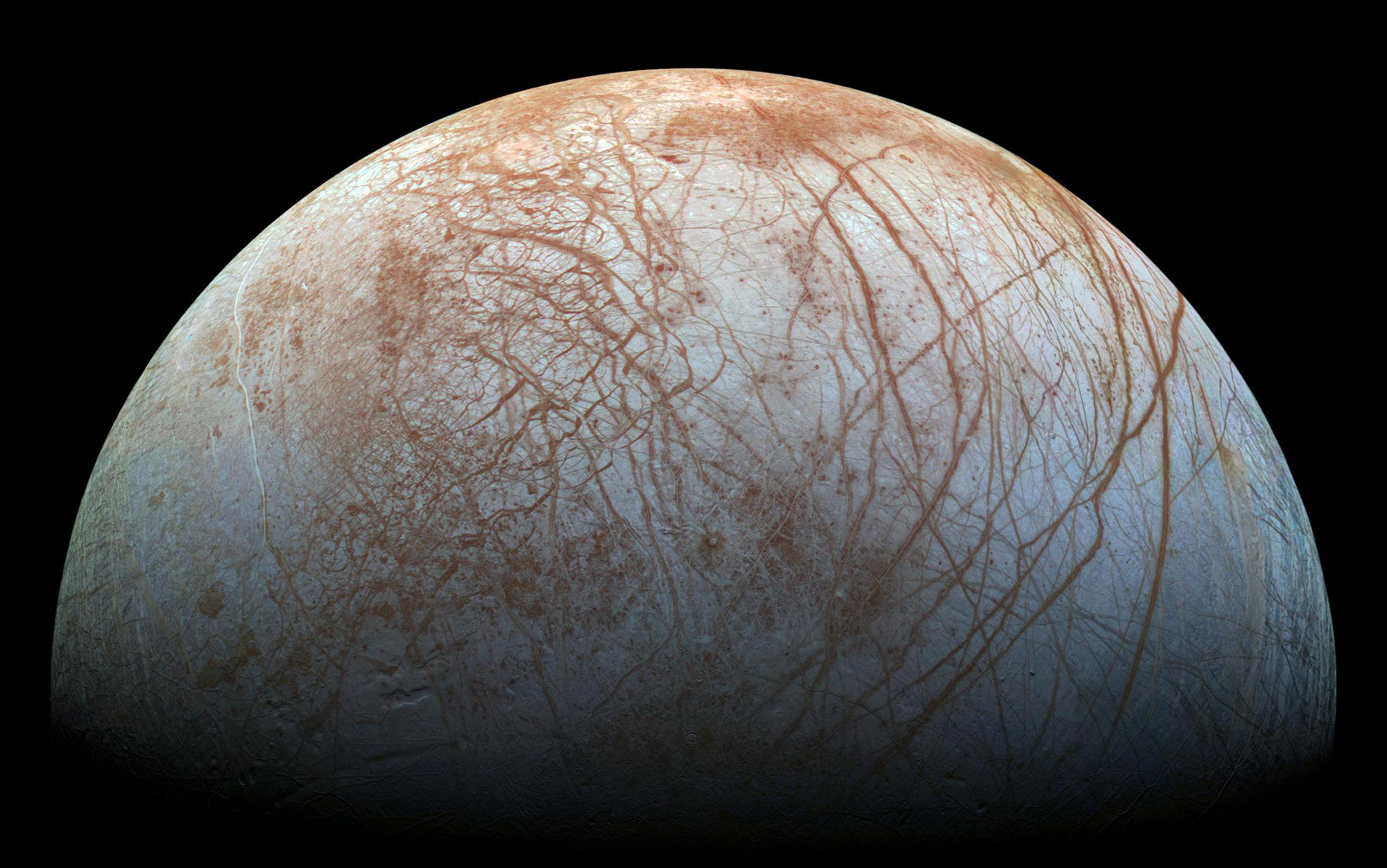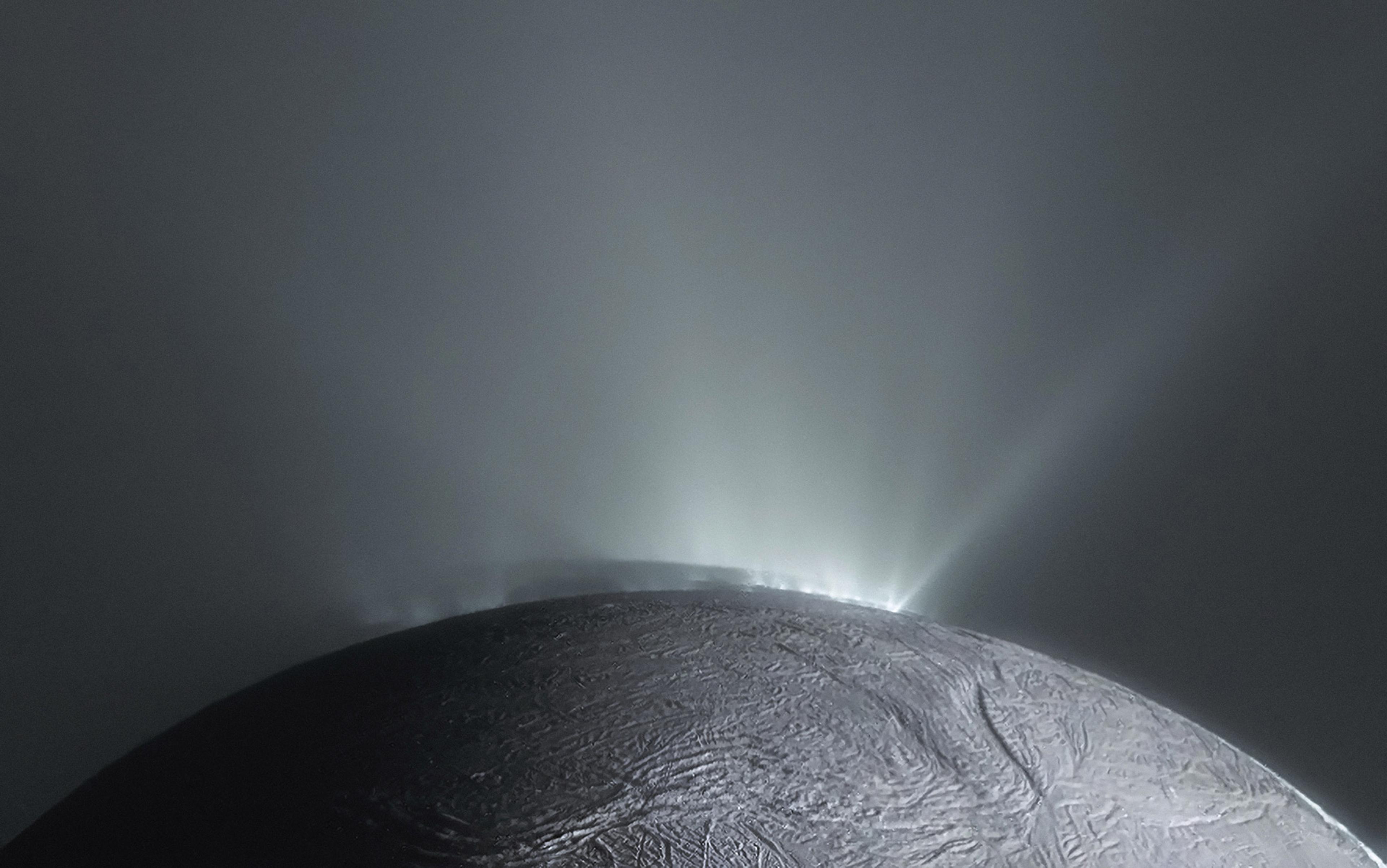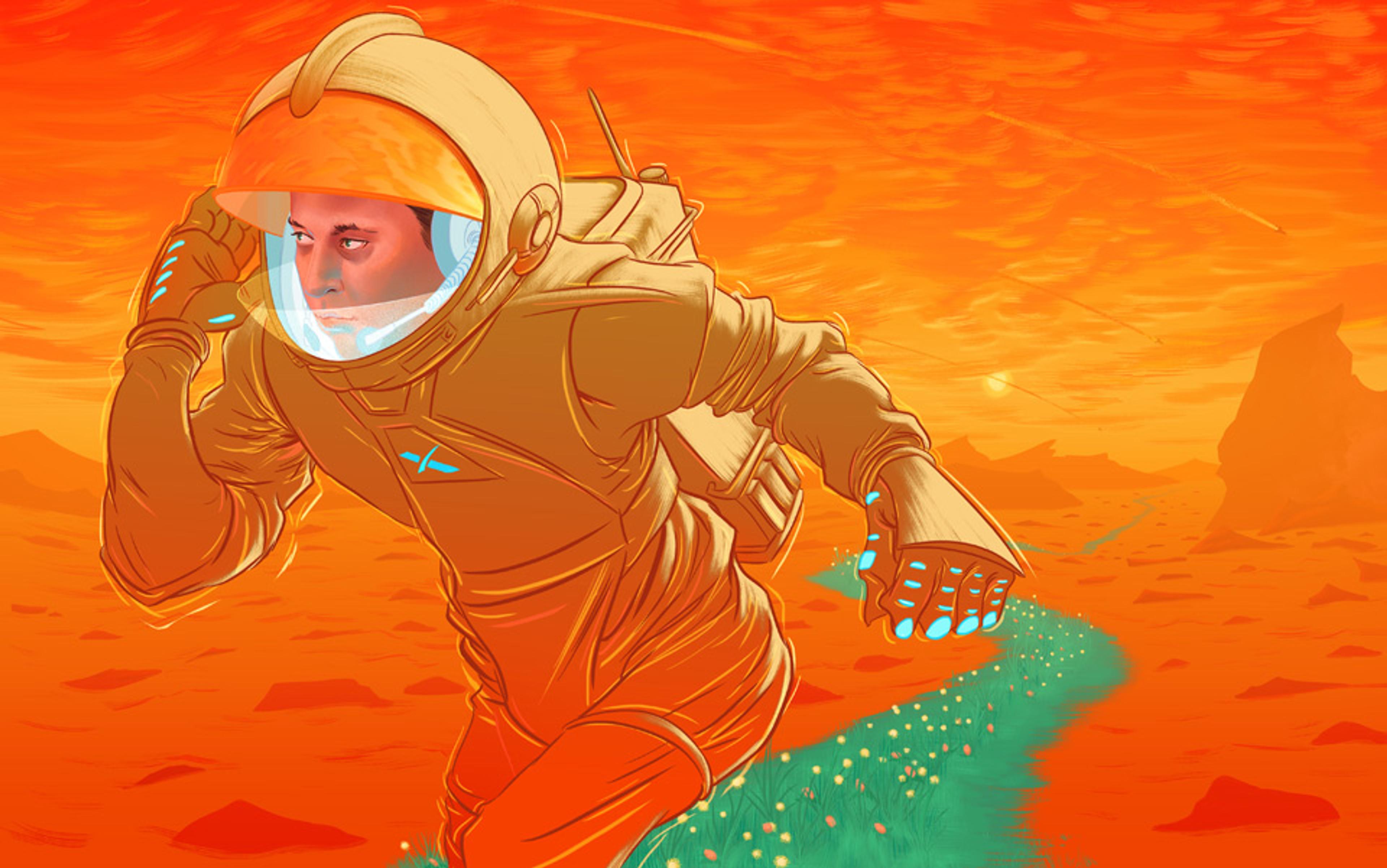The robots come to Mars out of a sky tinged peach from whirlwind-lofted dust. They cut through the thin, cold air in supersonic aeroshells and parachutes, making planetfall in bouncing airbag cocoons and bursts of braking retrorockets, bristling with cameras and spectrometers, antennas and manipulator arms. Some stay where they land; others rove for years on end. Sniffing the air, sifting through soil, wheeling across a cratered landscape, the robots doggedly seek any wisp of Martian moisture, like lost desert travellers dying of thirst. They are looking for life, following a strategy that NASA officials describe as ‘following the water’.
This strategy pays heed to water’s eerie harmony with life: wherever one is found on Earth, the other isn’t far behind. There are good reasons to believe that water is the ideal cornerstone of biology, not only on Earth, but elsewhere in the Universe. All you need to make it is hydrogen and oxygen, respectively the first and third most abundant elements in the cosmos.
In liquid form, water is unparalleled in its attunement to life’s needs. It facilitates the transmission of biochemical energy, nutrients, and waste. It shapes the structures and interactions of proteins and other macromolecules. It shields against hostile cosmic radiation, and it has a remarkably robust capacity for retaining warmth. Most strangely, unlike almost every other substance in the Universe, when water freezes, it expands instead of contracting, forming a protective, insulating shell of ice at its surface. This helps oceans, lakes, and other liquid reservoirs avoid freezing solid when exposed to prolonged cold.
For researchers who study Mars, following the water has paid off handsomely. Every mission sent to Mars seeking water has found it and, as a result, we now know that our neighbouring world used to be a warmer, wetter, more habitable place. Billions of years ago, that all changed, as the planet cooled and lost most of its air and water, and settled into a quiet senescence. But present-day Mars still harbours a slumbering aquasphere, locked in the ground as ice, which may stir every so often, erupting to the surface in evanescent briny flows.
Officially, the next stage of NASA’s Mars exploration programme is to ‘seek signs of life’, a phase that supposedly began in the summer of 2012 with the successful landing of the car-sized Curiosity rover. It’s true that Curiosity can sniff out organic carbon in samples of Martian rock and soil, but it mostly seems to be following the water, too. So far, it has rolled through what looks to be an ancient dried-up riverbed, and found evidence suggesting that some of Mars’s ancient water was fresh enough to drink.
Whether there is or ever has been anything on Mars to actually drink it is, surprisingly, not a question that Curiosity is well-equipped to answer, though it should have lots of time to try. Thanks to its nuclear power source, Curiosity could roam for at least 14 years, long enough to be joined by several more planned orbiters, landers, and rovers, bringing the total number of robots investigating Mars to perhaps a dozen. For the foreseeable future, Mars will be the focal point of our planetary science, dwarfing all other efforts to explore elsewhere in the solar system.
Our current explorations of Mars have become cautious and procedural, perhaps to a fault, as a result of past overreaches in the search for Martian life. The strategy of following the water emerged in the long aftermath of NASA’s costly and ambitious Viking missions, which landed on Mars in 1976, seeking life and finding none. Mission-planners controversially included cameras in the Viking payloads, inspired by none other than Carl Sagan, who noted half-jokingly that a lander focused strictly on microbial life would risk missing any Martian polar bears that might wander by.
Of course, when the Vikings landed, no polar bears showed up, and no microbes did, either. Twenty years later, the chastened Mars-research community was still smarting from Viking’s sting and NASA held a press conference declaring that some of its scientists had discovered ‘microfossil’ evidence for life in a Martian meteorite. The microfossil interpretation was disputed before the ink dried on the breathless newspaper headlines, and within a few years it had been decisively debunked, but not before spawning a flurry of funding, which helped to produce today’s bumper crop of Martian robots.
looking for water on Mars has become one of the most humdrum pursuits imaginable
Our obsession with Mars arises out of its similarity to Earth, and its nearness. Finding something clearly alien on the planet next door – some bacterium not built around DNA or RNA, for instance – would tell us that life arose independently on two separate worlds orbiting our solitary yellow star. We could no longer consider ourselves alone, for we would know with great confidence that life is a truly cosmic phenomenon, as inevitable in our Universe as the galaxies, stars, and planets themselves.
A strategy of following the water has become a necessary but insufficient placeholder for this grand ambition, and sadly we can now expect a decades-long interlude before the real story begins. The uncomfortable truth is that, despite the technical tour-de-force of our robotic reconnaissance, looking for water on Mars has become one of the most humdrum pursuits imaginable in all of 21st-century space science. It is the safest possible bet, the astrobiological equivalent of the bland-yet-filling casserole your in-laws sometimes make. Most news stories trumpeting yet another aqueous Martian discovery (or rediscovery) speak more to a collective public amnesia than to any paradigm-shifting knowledge being gained.
Indeed, scientists who specialise in Mars have been forced to dial down their dreams, hypothesising ever-smaller windows of opportunity for past life on the red planet, and ever more inaccessible refuges for anything now living there. Native Martians, if they exist at all, are most probably microbes clinging to life almost unreachably deep beneath the surface. This does not diminish the importance of exploring our neighbouring planet, but it must be admitted that there might well be more promising places to seek alien life. Indeed, if following the water is the prime directive in the search for extraterrestrial life, it increasingly appears that we should look beyond Mars to an icy moon of Jupiter called Europa.
It is a cold Sun that shines down on Jupiter and its moons, a dim bulb some four times smaller in size and about a 30th the brightness of the life-giving orb we see in Earth’s skies. For decades, most scientists thought that the water in Jupiter’s light-starved system would be granite-hard ice rather than life-giving liquid. But that view began to change in 1979, when NASA’s Voyager 1 and 2 spacecraft captured images of Europa as they soared past Jupiter on a grand tour of the outer solar system.
Europa is roughly the same size as Earth’s Moon, and some researchers thought that it too might have an ancient, inert surface scarred by giant impact craters. Instead, they were surprised to see Europa bearing a bright and icy crust relatively free of blemishes, a sign that its outer shell is active enough to hide the telltale craters that scar the face of a world over geological time.
they found signs of an electrically conductive layer beneath Europa’s surface, precisely where a tidally heated reservoir of salty, conductive seawater would be
But Europa’s crust wasn’t wholly flawless – a jigsaw-puzzle network of cracks and fissures snaked across its surface. The cracks were filled with reddish-brown mineral salts that had welled up from the depths, and their spidery patterns suggested the whole crust was sliding over a deeper layer that was warm, wet, and slippery – a potential subsurface ocean. Investigators postulated that as Europa swung to and fro around Jupiter, tidal forces from the giant planet were causing the moon’s interior to flex, warming it through frictional heat like a paper clip bent back and forth in the palm of a hand. Though Europa’s crust was young, an ocean beneath it produced by tidal heating could likely have existed nearly as long as the Jovian system itself, offering billions of years of time for life to arise and evolve in its depths.
Confirmation of Europa’s ocean would not come until the mid-1990s, when NASA’s Galileo spacecraft slipped into orbit around Jupiter and began close-up studies of its most tantalising moon. It imaged ‘chaos terrains’ where upwelling molten material had ruptured the ice into jumbled slurries of slabs, like icebergs tumbling in a frozen sea. Later, when measuring Europa’s magnetic field, the spacecraft found global signs of an electrically conductive layer beneath the surface, precisely where a tidally heated reservoir of salty, highly conductive seawater would be.
If Europa is alive, if some biology dwells within those dark waters, the implications would be even more staggering than finding life on Mars. Our gaze would turn to Jupiter’s Ganymede next, and to Callisto, along with Saturn’s Titan and Enceladus, and perhaps even the dwarf planets such as Ceres and Pluto, all of which also likely harbour substantial subsurface reservoirs, heated through some combination of tides and radioactive decay.
And if water and life could exist there, why not in the hearts of large comets, before the Sun’s planets and moons even finished forming? Our solar system might have brimmed with hidden life for nearly as long as the Sun has shined, and ice-roofed worlds might be the default abodes for biology in the Universe. Life within a roofed world could proceed swimmingly against any number of otherwise-fatal cosmic calamities, whether being slingshotted into the interstellar dark as a rogue planet, or being bathed in hard radiation from a nearby supernova or burping black hole. We could then guess why, like our solar system, the Universe at large looks so desolate to us. In this scenario, most life, even if it had eyes to see, would never glimpse sky, stars, light, or fire, and would have scant hope of ever reaching what lies above and beyond its icy shell.
After the revelations of Galileo, a minor cottage industry arose among planetary scientists estimating the volume of Europa’s ocean and the thickness of overlying ice, all in hopes of pinning down what sort of life might exist in that dark watery world – and how accessible it might be to future probes. After more than a decade of debate, the general consensus is that Europa’s abyss is more than 100km deep, holding double or even triple the amount of water in Earth’s oceans.
Whether the ice is thick or thin, the key question facing astrobiologists is really whether sufficient free energy exists within Europa’s sunless depths to support a biosphere – for life, if it is anything, is hungry. If scant useful energy is available beneath Europa’s ice, as many researchers suspect, the ocean could at best be a sparsely populated habitat for alien microbes. But if energy is plentiful, Europa could boast rich ecosystems of complex multicellular organisms – perhaps even something as magnificent and fearsome as Earth’s predatory deep-sea giant squid.
Europa probably offers a rich haven for extraterrestrial life right now
Based on measurements of its density, Europa should have an iron core sheathed by a mantle of silicate rock. This rock likely constitutes the bottom of the ocean, and is the probable source of the mineral salts that well up to the surface – a useful influx of chemical energy and raw construction materials for life. On Earth, communities of organisms thrive on the sea floor, utterly isolated from the surface and sunlight, living off chemical reactions driven by hydrothermal vents. Relocated to hydrothermal vents in the Europan depths, they might conceivably thrive there, too.
Many scientists suspect such sea floor oases were where our planet’s life first emerged from inanimate matter. If the overlying ice crust is thin and mobile enough, useful energy could also trickle down from above, via heat and ejecta from the occasional cometary impact, or from the upwelling mineral salts that oxidise at the surface before slowly filtering down through fractures in the ice. It increasingly seems that, unlike Mars, which, just maybe, might have been able to support a robust biosphere deep in its geological past, Europa probably offers a rich haven for extraterrestrial life right now.
So why then, one might wonder, with so much promise for life on Europa, are we lavishing attention on Mars? Why are we chasing ice crystals underneath a desert instead of seeking out alien seas?
For one, Europa is much harder to get to than Mars, and much less hospitable when you arrive. Current space-based solar power systems can barely generate sufficient electricity from the sunlight available at Jupiter, and the meagre nuclear power sources presently available to civilian space agencies are, by and large, already committed to upcoming Mars missions. Due to its powerful magnetic field, which acts like a giant particle accelerator, Jupiter also creates an extremely hazardous radiation environment at Europa’s surface, sufficient to give a spacesuited human a fatal dose in a matter of hours. Even a robotic orbiter or lander must be heavily shielded, at great expense, if it is to withstand such bombardment.
There is also the question of penetrating Europa’s icy shield. Perhaps abnormally thin regions of crust could be found, allowing a robotic submersible to be slipped down a borehole made with mechanical drill or a nuclear-powered melter, but the cost would be staggering – imagine the expense and difficulty of setting up a deep-sea oil-drilling platform not in the Gulf of Mexico, but on another world. In an earlier time of more plentiful funding, NASA estimates guessed that even a simple Europa orbiter – never mind any tunnelling landers or radioactive cryobots – would cost nearly $5 billion, though later efforts suggested a bare-bones mission could be had for approximately $2 billion.
Fly a spacecraft through or near a plume, and, who knows, you might even catch a flash-frozen fish
Yet the more closely we examine Europa, the more its complexities seem to offer a cheaper, faster pathway to knowing its ocean. Late last year, a team of researchers used the Hubble Space Telescope to detect plumes of water vapour gushing some 200km out from regions around Europa’s south pole, venting an estimated 7000kg of water per second into space. The plumes seem to occur when Europa is at its farthest orbital separation, suggesting they’re driven by fissures that open and close, cyclically, as the moon flexes from Jupiter’s tidal pull.
Whether the plumes are connected to the deep ocean itself, or to a population of smaller, sea- or lake-sized reservoirs closer to the surface, remains unknown. What’s certain is that all that vented water should be carrying contaminants, too – vestiges of other physical, chemical, potentially even biological processes, taking place deeper within Europa. Fly a spacecraft through or near a plume, and, who knows, you might even catch a flash-frozen fish.
Only one mission capable of the task is presently funded, the European Space Agency’s Jupiter Icy Moons Explorer (JUICE), slated to launch in 2022 and arrive at Jupiter in 2030. But JUICE won’t orbit Europa, and might only encounter the moon twice on its three-year mission, which might not be enough to sample the transient plumes. At the urging of the US Congress and the Obama administration, NASA is now studying the feasibility of its own Europa mission. Yet the very same politicians encouraging NASA to look to Europa have failed to give it the true freedom to do so: budgetary squabbling has reduced NASA’s targeted pricetag for a Europa mission to less than $1 billion, which is less than half the cost of its previous estimates for a bare-bones mission.
Meanwhile, Mars beckons from right next door, and we heed the call, like young children setting out to see the wide-open world by overnighting in a backyard tent. Perhaps it can’t be helped. Perhaps it shouldn’t be. Beyond the pressures of time, energy, and money that make exploring Europa seem so prohibitive, there is also the problem of human psychology.
Even if Mars proves totally, irrevocably dead, one can still squint up at its ruddy disk in the night sky, and envision a better future for it. Someday, humans might walk there, perhaps even live. No one has such dreams for Europa. If Mars is a warped mirror we stare into, while imagining ourselves as explorers in some pleasantly familiar frontier future, then Europa must be a locked door, or maybe a matte-black monolith, cold and indifferent, an abyss that might, some day, gaze back at us, if only we could first convince ourselves to look.






